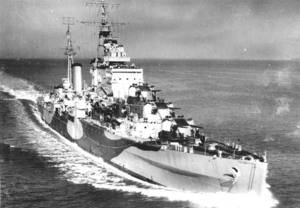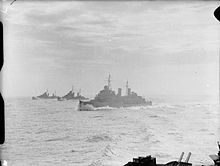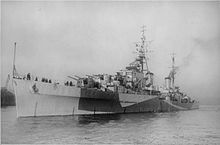- Dido class cruiser
-

HMS Argonaut in wartime camouflage, November 1943 just after repairs at Philadelphia Navy yardClass overview Name: Dido Operators:  Royal Navy
Royal Navy
 Royal New Zealand Navy
Royal New Zealand Navy
 Pakistan Navy
Pakistan NavyPreceded by: Town class Succeeded by: Crown Colony class Subclasses: Dido
BellonaIn commission: 1940-1966 Completed: Sixteen Lost: Five General characteristics Type: light cruiser Displacement: Standard: 5,700 to 5,900 tons
Full load: 6,900 to 7,600 tonsLength: 512 ft (156 m) overall Beam: 50 ft 6 in (15.39 m) Draught: Dido class: 14 ft (4.3 m)
Bellona class: 15 ft (4.6 m)Propulsion: Four Admiralty 3-drum boilers
Four Parsons steam turbines
Four shafts
62,000 shp (46 MW)Speed: 32.25 knots Range: 1,100 tons fuel oil
2,414 km (1,500 mi) at 30 knots
6,824 (4,240 miles) at 16 knotsComplement: Dido class: 480
Bellona class: 530Armament: Dido class designed:
Ten QF 5.25-inch (133 mm) guns in five dual mounts,
Two quadruple 0.5 inch Vickers machine gun mounts,
Two quadruple QF 2 pdr (40 mm) pom-pom mounts.
Two triple 21 inch (533 mm) torpedo tubes.Bellona class as designed:
Eight QF 5.25-inch (133 mm) guns in four dual mounts,
Six twin 20 mm gun power-operated mounts,
Three quad mount QF 2 pdr (40 mm) pom-poms,
Two triple mount 21 in (533 mm) torpedo tubes.The Dido class was a class of sixteen (including the Bellona sub-class) light cruisers built for the Royal Navy. The design was influenced by the Arethusa class light cruisers. The first group of three ships was commissioned in 1940, the second group (six ships) and third group (two ships) were commissioned in 1941–1942. The Bellona class ships commissioned between 1943 to 1944. Most members of the class were named after figures of Greek mythology.
They were designed as fleet escorts to protect heavier units from both light surface forces and aircraft. The enthusiasm felt for them by the Board of Admiralty was borne out by good results in action and the only real problem with the type was shortage of gun-mountings and a need to stiffen them forward to take the weight of the forward turrets.
Contents
Armament


HMS Cleopatra throws out smoke to shield a convoy as HMS Euryalus elevates her forward 5.25 inch guns to shell the Italian Fleet at the Second Battle of Sirte, 22 March 1942 The class were intended to be armed with ten 5.25 inch (133 mm) guns in five twin turrets, which were of the same circular design as the secondary armament in the King George V class battleships. A shortage of the guns, due to difficulties in manufacturing them, led to the first group being armed with only eight 5.25 inch guns in four twin turrets. The fifth twin turret was added later to Dido only. The first group was also armed with a single 4 inch (102 mm) gun and two quadruple QF 2 pounder (40 mm) "pom-poms".
The second group had the full five twin 5.25 inch guns but did not have the single 4 in (102 mm) gun added. The third group's armament was completely changed due to the shortage of the 5.25 in gun, being armed with eight 4.5 inch (113 mm) guns in four twin turrets instead. The 4.5 inch gun was actually better suited to the primary anti-aircraft role of the Dido class. The single 4.0 inch (102 mm) gun was also re-introduced, and its 2 pounder armament was increased from eight to ten.
The Bellona sub-class differed appearancewise somewhat from their predecessors. They had eight 5.25 inch (133 mm) RP10MkII guns in four twin turrets, and had vastly improved anti-aircraft armament, with twelve 2 pounder guns and twelve Oerlikon 20 mm cannons. The bridge of the Bellona-class was lowered by one deck compared to the previous three groups, which allowed full radar control to be fitted to the 5.25 inch (133 mm) turrets and 2 pounders, due to the decreased topweight. These ships used the HACS high angle fire control system. The two funnels were more upright than the raked ones of the original Dido-class.
Service
In World War II, the ships of this class saw much action, including the battle of Cape Matapan, the Second Battle of Sirte, Operation Torch, Operation Overlord, and the battle of Okinawa, as well as many other duties in the Mediterranean and Pacific, indeed the Didos saw even more service than is mentioned here. The class lost a number of ships during the war. These were Bonaventure, Charybdis, Hermione, Naiad, Scylla and Spartan. The post-war survivors continued in service; all were decommissioned by the 1960s. Bellona, Black Prince and Royalist were loaned to the Royal New Zealand Navy post-World War II. In 1956, Diadem was sold to Pakistan and renamed Babur.
Ship modifications
Didos
Bonaventure completed with only four twin 5.25 in turrets because of shortages, and received a 4 inch starshell gun in X position. She had received a radar set before October 1940, but was otherwise unaltered.
Naiad completed with five turrets. She received five single 20 mm in September 1941 and had radar Type 279 by this time.
Phoebe completed with four turrets and was fitted with a 4 inch in Q position forward of the bridge. The latter was landed during her refit between November 1941 and April 1942, at New York, along with the .5 inch machine guns and Type 279 radar, while a quadruple 2 pdr supplanted the 4 inch and eleven single 20 mm guns were fitted. Radars were now Type 281, 284 and 285. The A turret was temporarily removed at the end of 1942 after torpedo damage. During repairs in the first six months of 1943, all three quadruple 2 pdr were landed, as were seven single 20 mm, to be replaced by three quadruple 40 mm Bofors guns and six twin 20 mm. Radar Type 272 was also fitted. The A turret was replaced in July 1943. Her light anti-aircraft weaponry in April 1944 was twelve 40 mm (3 × 4) and sixteen 20 mm (6 × 2, 4 xl).
Dido had four turrets and a 4 inch similar to Phoebe. The 4 in and the machine guns were removed in the latter half of 1941 at Brooklyn Navy Yard, when Q 5.25 in turret was shipped and five single 20 mm were fitted. In the early summer of 1943 three single 20 mm were exchanged for four twin 20 mm, and the radar outfit was altered by the addition of Types 272, 282, 284 and 285. April 1944 lists, however, show only eight 20 mm.
 The cruisers HMS Edinburgh, HMS Hermione, and HMS Euryalus, steaming in line abreast whilst they escort a convoy as part of Operation Halberd, - convoy not visible.
The cruisers HMS Edinburgh, HMS Hermione, and HMS Euryalus, steaming in line abreast whilst they escort a convoy as part of Operation Halberd, - convoy not visible.
Euryalus completed with her designed armament. In September 1941 the .5 in MGs were landed and five single 20 mm fitted. Two more were added by September 1942. By mid-1943 two single 20 had been removed and four twin 20 mm shipped. The type 279 radar was replaced by types 272, 281, 282 and 285. In a long refit from October 1943 to July 1944, Q turret was replaced by a quadruple 2 pdr and two twin 20 mm were fitted. Radar 271 and 272 were removed and types 279b, 277 and 293 fitted.
Hermione also completed as a five-turret ship. She had the .5 in MGs removed in October/November 1941 and received five single 20 mm.
Sirius completed with five turrets and five 20 mm singles. She had received two more single 20 mm by mid-1943. One of these was landed at Massawa at the end of 1943, and two single 40 mm Bofors Mk III were fitted. However, she is listed as having only seven 20 mm as light AA in April 1944 lists. By April 1945 she had two single Mk III 40 mm fitted and had landed two single 20 mm.
Cleopatra was completed with two single 2 pdr in 1942 in lieu of the .5 in MGs, but these were removed in the middle of that year and replaced by five single 20 mm. A sixth 20 mm was added in mid-1943. During repairs between November 1943 and November 1944, Q turret was removed, as were two quadruple 2 pdr and five single 20 mm. Three quadruple 40 mm Bofors and six twin 20 mm were fitted and the singles numbered four.
Argonaut completed with four single 20 mm in lieu of the .5 in MGs. She had Q turret removed during repairs in 1943/44, and lost the four single 20 mm. She received a quadruple 2 pdr in lieu of the 5.25 in, and had five twin 20 mm fitted. By April 1944 her light AA comprised three quadruple 2 pdr, six twin power-operated 20 mm and five single. By the end of the war with Japan she had received five 40 mm Bofors and three single 40 mm Bofors Mk III.
Scylla completed with four twin 4.5 in Mk III in UD MK III mountings because of a shortage of 5.25 in mountings. The forward superstructure was considerably modified to accommodate these and also to increase crew spaces. Her light AA on completion was eight single 20 mm. Six twin power-operated 20 mm were added at the end of 1943.
Charybdis also completed with four twin 4.5 inch, and had in addition a single 4 in Mk V for-ward of X mounting. Her light AA at completion was four single 20 mm and two single 2 pdr. The 4 inch starshell gun and two single 2 pdr were removed and replaced by two twin and two single 20 mm, probably in 1943.
Bellonas
 HMS Diadem of the Bellona sub-class
HMS Diadem of the Bellona sub-class
Spartan received no alterations as far as is known.
Royalist was converted to an Escort Carrier Squadron flagship immediately on completion, when an extra two twin 20 mm were fitted as well as four single 20 mm. She was the only ship to receive an extensive postwar modernisation. (Loaned to RNZN in 1956, in exchange for Bellona).
Bellona had four single 20 mm added by April 1944, and received an extra eight single 20 mm by April 1945. (Loaned to the RNZN after the war).
Black Prince and Diadem also received eight single 20 mm, and had a further two twin 20 mm by early 1945. (Black Prince was loaned to the RNZN after the war; Diadem was sold to Pakistan in 1956, and was renamed Babur).
In popular culture
- HMS Ulysses (1955 novel by Alistair Maclean)
- In the 1953 film of C.S.Forester's Brown on Resolution, (called Sailor of the King in Britain, and Single-handed in the USA), the Dido-class HMS Cleopatra plays both the fictional Royal Navy ships "HMS Amesbury" and "HMS Stratford". As Amesbury she is heroically sunk by the more powerful German raider Essen, (portrayed by HMS Manxman with large mock-up gun turrets), and as Stratford she triumphs at the end of the story. The two battle sequences depict this open-bridge light-cruiser firing her guns and torpedoes in some detail.
Notes
References
- Colledge, J. J.; Warlow, Ben (2006) [1969]. Ships of the Royal Navy: The Complete Record of all Fighting Ships of the Royal Navy (Rev. ed.). London: Chatham. ISBN 978-1-86176-281-8. OCLC 67375475.
- Dido class at Uboat.net
- Bellona class at Uboat.net
- WWII cruisers
External links
- Gunnery Layout of a "Dido" Class Cruiser. from Gunnery Pocket Book 1945 placed online courtesy of Historic Naval Ships Association
- Newsreel video of HMS Scylla fighting the Luftwaffe while protecting convoy PQ18
- Our Navy in Action; newreel footage of Dido class cruisers engaging Axis aircraft and Italian battleships during the Battle of Sirte on 22 March 1942
- Short video clip of a Dido class cruiser in action
Dido-class cruiser Royal NavyDido groupBellona group
Royal NavyDido groupBellona groupBellona · Black Prince · Diadem · Royalist · Spartan
 Royal New Zealand Navy
Royal New Zealand Navy Pakistan NavyCategories:
Pakistan NavyCategories:- Cruiser classes
- Dido class cruisers
Wikimedia Foundation. 2010.
